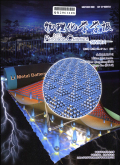物理化学学报2024,Vol.40Issue(4):11-25,15.DOI:10.3866/PKU.WHXB202305019
电催化两电子水氧化制备过氧化氢的研究进展
Recent Advances in Electrocatalytic Two-Electron Water Oxidation for Green H2O2 Production
摘要
Abstract
Hydrogen peroxide(H2O2)is an environmentally friendly oxidant that has been widely used in water treatment,medical disinfection,chemical synthesis,and other industrial applications.However,traditional methods used to produce H2O2 consume significant amounts of energy and generate hazardous by-products,which limit their scope.On-site and on-demand electrocatalytic two-electron water oxidation chemistry is an attractive option for directly producing H2O2 from water;it also avoids the hazardous anthraquinone method,has fewer transportation costs and risks,and is integratable with renewable electricity.Despite these advantages,the two-electron water oxidation reaction(2e-WOR)still suffers from poor selectivity and activity due to a lack of mechanistic,material-design,and reactor-engineering understanding.This study summarizes recent advances in H2O2 electrosynthesis technology using the 2e-WOR.The catalytic 2e-WOR mechanism is first introduced with a focus on selectivity,activity,and stability.This reaction involves the electrocatalytic oxidation of water to produce H2O2,which can be further oxidized to O2.Selectivity is influenced by a variety of factors,including the electrocatalyst,pH,and electrolyte.Various quantitative H2O2 methods are discussed along with in situ characterization studies into the 2e-WOR aimed at better understanding the reaction process.Such methods include in situ Fourier-transform infrared spectroscopy and in situ Raman spectroscopy.Researchers are able to identify reaction intermediates and understand reaction mechanisms better using these techniques,thereby providing guidance for the design of more efficient electrocatalysts.In turn,various strategies for preparing high-performance electrocatalysts are summarized,including defect,doping,facet,and interfacial engineering methods.Mechanism-guided multiscale materials engineering can improve the activities and selectivities of electrocatalysts,thereby increasing H2O2 yields.In addition,device-level engineering,especially in relation to reactor and system innovations,is emphasized,which is important for improving reaction efficiency and reducing the cost of the 2e-WOR.Finally,current challenges and future opportunities in the 2e-WOR H2O2 electrosynthesis field are discussed.More effort directed at improving reaction selectivity,activity,and durability is required,along with exploring suitable application scenarios.The 2e-WOR is expected to become a more sustainable and efficient method for producing H2O2 facilitated by continuing progress in the materials science and electrochemical technology fields.关键词
水氧化反应/过氧化氢/催化剂设计/电化学机理/理论研究Key words
Water oxidation reaction/Hydrogen peroxide/Catalyst design/Electrochemical mechanism/Theoretical study分类
化学引用本文复制引用
林柳,唐城,孙泽民,陈华添,赵莲,孙明月,杨逸涛,廖振升,吴鑫宇,李欣欣..电催化两电子水氧化制备过氧化氢的研究进展[J].物理化学学报,2024,40(4):11-25,15.基金项目
The project was supported by the Natural Science Foundation of Guangdong Province,China(2023A1515010554).广东省自然科学基金(2023A1515010554)资助项目 (2023A1515010554)

